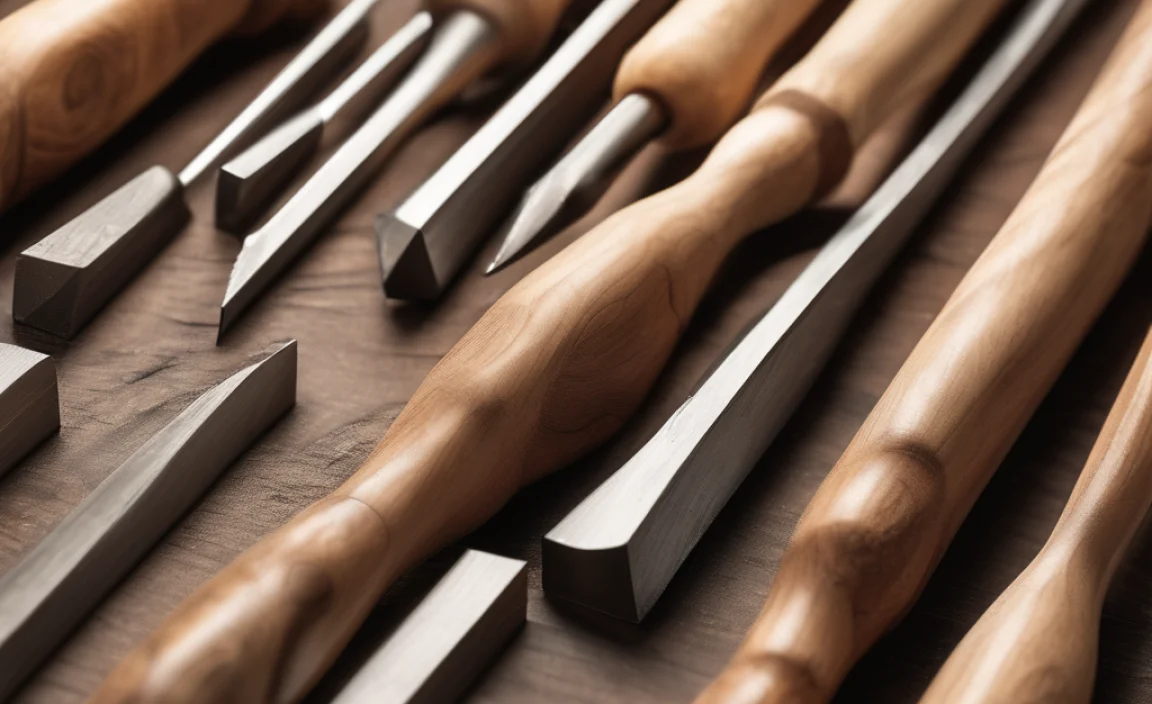Have you ever seen a spinning piece of wood turning into art? This magic happens with wood lathes. But, to make creations, we need the right chisels. Wood lathe chisels for beginners are important tools. These tools help us shape wood safely and accurately. How do we start using them? Let’s explore this exciting world together!
Key Takeaways
- Wood lathe chisels are essential for shaping wood.
- Beginners need sharp, appropriate chisels for safety.
- Learn basic chisel types for easy wood carving.
- Wood lathe chisels for beginners come in sets.
- Regular practice improves chisel handling skills.
Choosing Wood Lathe Chisels For Beginners

Choosing the right chisel set can be daunting for beginners. The first step is understanding the different chisel types. Each has a unique purpose and shape. Beginners should look for a set that includes basic chisels. Some common chisels are gouges, skew chisels, and parting tools. Gouges are often used for rough shaping. Skew chisels provide smooth surface cuts. Parting tools help to cut into the wood, separating it into parts.
- Determine the type of wood you will use.
- Identify the style of projects you like.
- Consider the size and weight of the chisel.
- Look for a comfortable handle grip.
- Check for quality steel for durability.
- Read reviews from other beginners.
When selecting a chisel set, prioritize quality over quantity. A few good chisels are better than many poor ones. Test the chisels if possible. Feel the weight and balance. It’s important they feel comfortable in your hand. The handle should fit well in your grip. This ensures you can control the chisel easily. Remember, safety and comfort are crucial when using these tools.
Fun Fact: Some woodworkers name their favorite chisels, like pets or friends!
Understanding Chisel Types
Did you know there are many chisel types? Each one has a special job. Gouges, skew chisels, and parting tools are the most common. Gouges help shape the wood roughly. Skew chisels make surfaces smooth. Parting tools cut and separate pieces. It’s like having different brushes for painting. Each chisel adds a unique touch to your wood creation. Knowing your chisels makes your work easier and more fun!
Which Wood Is Best?
When starting with woodturning, choosing the right wood is vital. Softwoods, like pine, are easier to shape. They are forgiving for beginners. Hardwoods, like maple, offer more resistance. This can be challenging but rewarding. Consider what you want to create. Small projects use small, softer wood pieces. Large projects may need stronger wood. Think about your tools, too. Are they ready to handle hard wood?
Comfortable Handles Matter
Have you ever held a tool that felt wrong in your hand? A comfortable handle makes a big difference. It affects how long you can work and how well you control the chisel. Look for handles that fit your hand size. Some handles have special grips. These prevent slipping. Choose a handle material you like. Wood feels warm. Plastic may offer more grip. Metal is extra durable. Try holding different types to see what feels best.
Understanding Chisel Safety
Safety is a top priority when using wood lathe chisels for beginners. Always wear protective gear. Goggles protect your eyes from wood chips. Gloves keep your hands safe from splinters. It’s also important to secure the wood piece tightly. This prevents it from spinning out of control. Be mindful of your working area. Keep it clean to avoid accidents. Make sure your tools are sharp. Dull tools can slip and cause injuries.
- Wear goggles to protect your eyes.
- Use gloves to safeguard your hands.
- Secure wood pieces firmly on the lathe.
- Maintain a clean workspace.
- Keep tools sharp for safe cutting.
- Learn and follow all safety guidelines.
Understanding and following safety measures can prevent accidents. It’s crucial to be attentive while working. Never rush your projects. Patience leads to better and safer results. Take breaks when needed. Rested hands and eyes are less prone to mistakes. Remember, safety is the foundation of a successful woodturning journey.
Fun Fact: Some woodworkers wear special aprons with pockets for tools and snacks!
Importance of Sharp Tools
Have you tried cutting with a dull knife? It’s frustrating and unsafe. The same goes for wood lathe chisels. Sharp chisels cut cleaner and easier. They also reduce the risk of slipping. Dull chisels require more force. This can lead to mistakes or injuries. Regularly sharpen your tools. Invest in a good sharpening stone. Practice sharpening to maintain your chisels’ edge. It’s like brushing your teeth. Regular care keeps them in top shape.
Securing Your Workspace
A tidy workspace is a safe workspace. Keep tools organized and within reach. Clear away wood chips and dust regularly. This prevents slipping and tripping. Ensure your lathe is stable. Use a sturdy table or bench. Good lighting helps you see details better. Arrange your tools in a logical order. This makes them easy to grab. A well-organized space boosts your confidence. You can focus on creativity without distractions.
Wearing Protective Gear
Have you ever seen a superhero without their suit? Protective gear is your suit in woodworking. Goggles shield your eyes from flying wood chips. Gloves protect your hands from splinters. Some woodworkers use ear protection. The lathe can be noisy over time. An apron guards against dust and dirt. Wear clothes that fit snugly. Loose fabric can catch on spinning parts. Dressing safely is as important as knowing your tools.
Practicing with Wood Lathe Chisels
Practice makes perfect with wood lathe chisels for beginners. Start with simple projects. Small shapes teach you control. Begin with softwood. It’s easier to carve and forgiving of mistakes. Repeat basic cuts to build skill. As you gain confidence, try more complex designs. Join a club or class. Learning with others is fun and motivating. Don’t worry about perfection. Every project teaches something new.
- Start with simple projects.
- Use softwood for easy carving.
- Practice basic cuts for control.
- Gradually try complex designs.
- Join a club or class for support.
- Learn from mistakes and keep improving.
Regular practice builds familiarity. You’ll notice your skill improving over time. Take breaks and step back to see your progress. Celebrate small wins. Each completed project is a step forward. Remember, even the best woodworkers started as beginners. Keep a record of your work. Photos or notes remind you how far you’ve come. Stay curious and keep experimenting with new ideas.
Fun Fact: Many famous woodworkers started as hobbyists in their garages!
Starting Simple Projects
Are you ready to start your first project? Choose something simple. A wooden spoon or small bowl is great for beginners. These projects teach basic shaping and carving. Use softwood like pine or cedar. It’s easy to work with. Draw or sketch your design before starting. This gives you a clear goal. Remember, it’s okay to make mistakes. Each mistake is a learning opportunity. Enjoy the process and have fun!
Joining Woodworking Classes
Why not learn with others? Woodworking classes can be exciting. You’ll meet people who share your passion. Instructors provide guidance and answer questions. Classes offer hands-on experience. You’ll get to use different tools. Some classes even provide materials. This saves you from buying everything at once. Sharing and comparing projects is rewarding. You might even make new friends. Learning together makes the experience more enjoyable.
Recording Your Progress
How do you track your journey? Keeping a record is helpful. Take photos of each project. Write down your thoughts and steps. Note what worked well and what didn’t. This helps you improve. Looking back shows your growth. You’ll see how your skills have advanced. Sharing your progress is inspiring to others. Maybe you’ll encourage a friend to start woodworking too. Celebrate your achievements along the way.
Common Mistakes and How to Avoid Them
As a beginner, it’s easy to make mistakes with wood lathe chisels. One common mistake is applying too much pressure. This can damage the wood or the tool. Another is choosing the wrong chisel for the task. Understanding each chisel’s purpose is crucial. Sometimes, beginners skip tool maintenance. Dull or dirty tools can cause errors. Always plan your project before starting. This ensures you have the right materials and tools ready.
- Avoid applying too much pressure while carving.
- Use the correct chisel for each task.
- Regularly sharpen and clean your tools.
- Plan your project before starting.
- Take your time and be patient.
- Learn from mistakes and adjust.
Patience is key to avoiding mistakes. Take your time with each step. If something goes wrong, don’t be discouraged. Analyze what happened and why. Adjust your approach and try again. Remember, even professional woodworkers face challenges. Each mistake is a valuable lesson. Stay positive and keep practicing. Your skills will improve with every project.
Fun Fact: Some woodworkers turn their mistakes into new designs!
Applying Pressure Correctly
Do you know how much pressure is enough? It’s a common beginner question. Too much force can ruin your work. It might damage the wood or tool. Start with gentle, controlled movements. Let the tool do the work. Feel the wood and watch how it reacts. Over time, you’ll develop a sense of the right amount of pressure. Practice on scrap wood to build confidence. This reduces the risk of mistakes on important projects.
Understanding Chisel Purposes
Have you used the wrong tool for a job? It’s frustrating, right? Each chisel has a specific task. Gouges shape and hollow. Skew chisels smooth surfaces. Parting tools cut and separate. Knowing what each does helps you work efficiently. Take time to learn about your chisels. Read guides or watch videos. Experiment with each tool on practice pieces. This builds your understanding and skill. It’s like building a toolbox of knowledge.
Maintaining Your Tools
Why is tool maintenance important? Well-maintained tools last longer and work better. Regular sharpening keeps your chisels effective. Clean tools after each use. Remove wood shavings and dust. Store them properly to prevent rust. Consider a tool roll or chest. Inspect your tools regularly. Look for wear or damage. Replace or repair as needed. Taking care of your tools shows respect for your craft. They’ll serve you well on your woodworking journey.
| Chisel Type | Use | Best For | Material |
|---|---|---|---|
| Gouge | Rough shaping | Curves | Steel |
| Skew Chisel | Smooth cutting | Flat surfaces | HSS |
| Parting Tool | Cutting into wood | Separation | Carbon Steel |
| Scraper | Smoothing | Finishing | HSS |
Conclusion
Wood lathe chisels for beginners open a world of creativity. Choose your tools wisely. Practice regularly and learn from each project. Safety always comes first. With time and patience, your skills will grow. Remember, every expert was once a beginner. Enjoy your woodworking journey. Create beautiful things from simple pieces of wood!
FAQs
Question: What are wood lathe chisels for beginners?
Answer: Wood lathe chisels for beginners are tools used to shape wood. They help carve and design wood pieces safely. Beginners should start with basic chisels like gouges and skew chisels. These tools are easy to use and perfect for learning.
Question: How do I choose a chisel set?
Answer: Choose a set that includes basic chisels like gouges and skew chisels. Check for comfortable handles and quality steel. Read reviews and maybe ask for recommendations. Visit stores to feel the weight and balance. A well-chosen set supports your learning journey.
Question: How can I ensure safety while using chisels?
Answer: Always wear goggles, gloves, and an apron. Secure the wood piece on the lathe. Keep your workspace clean and tools sharp. Follow safety guidelines and never rush your projects. These steps reduce the risk of accidents and injuries.
Question: What projects should beginners start with?
Answer: Start with simple projects like a wooden spoon or small bowl. These teach basic carving skills. Use softwood for easier shaping. Simple projects help build confidence and understanding of tools. As you improve, try more complex designs.
Question: How important is tool maintenance?
Answer: Tool maintenance is very important for effective woodworking. Regular sharpening keeps chisels sharp and ready. Clean tools after use to prevent rust. Store them properly and inspect regularly. Well-maintained tools work better and last longer.
Question: Can mistakes help me learn?
Answer: Yes, mistakes are valuable lessons. They show what to improve on. Analyze each mistake and adjust your approach. Stay patient and persistent. Even expert woodworkers learn from errors. Embrace mistakes as part of your growth.





